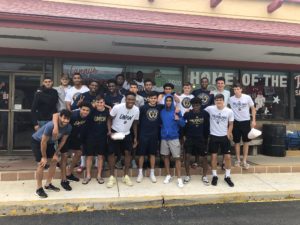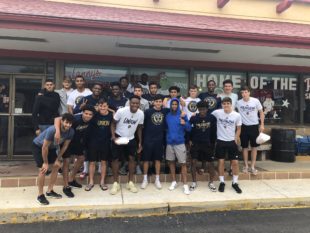Photo & caption courtesy Philadelphia Union II
The picture to the right crystallizes more than 1,000 words of explanation and four months of observation.
The Philadelphia Union II guys had been investigating whether Lenny’s was in fact the best breakfast in Clearwater.

L – R. Front: Issa Rayyan, Nate Harriel, Zach Zandi, Shanyder Borgelin, Axel Picazo, Tyger Evans, Kyle Gee, Cole Sotack. Back: Saed Diaz, Todd Morton, Yomi Scintu, Steve Kingue, Patrick Bohui, Jami Topey, Selmir Miscic, Aboubacar Camara, Dante Huckaby, Danny Flores, Jack McGlynn, Ben Ofeimu, Lukas Burns, Adam Lenges
The 22 players in the photograph trained in Florida from either Monday or Tuesday February 10 or 11 until they came home Sunday, February 23. While there, they scrimmaged Inter Miami FC behind hermetically sealed information doors.
They scrimmaged West Chester United in West Chester on Wednesday, February 26, winning 5-3. They had a closed-door scrimmage against fellow USL Eastern Conference member Hartford Athletic last Saturday. Hartford led 2-0 at half, and added a third after the interval. “The 2” then got a consolation goal towards the end.
Union II open their regular season this Saturday against Loudon United at Subaru Park at 7:30 pm. Of necessity we will learn their re-branded uniform kits then. Nor do we yet know what scarves, hoodies, t-shirts and other U2 “swag” will look like.
In a mixture of confirmed fact and informed speculation, here is what else we think we know.
Core principles
The core central purpose of the team is to evaluate whether Union Academy players should be offered professional contracts or continue their soccer in college. I suspect strongly this principle governs all others.
The core principle of the previous Bethlehem Steel FC, providing the first-team whatever it needed — reserves conditioned, injuries rehabilitated, and players developed — continues in place, intertwined with and only slightly outranked by Academy player growth and evaluation.
Ernst Tanner emphasizes youth. The average age of the squad in the picture plus the three young developmental players on the first team is exactly 19 years of age. The oldest, Todd Morton, is 24. The youngest, Patrick Bohui, is 16. Seven of the total are 20 years old or older; eighteen — 72% — are still teenagers as the season starts.
A final principle is that evaluation and development against adult professionals is more important than success in U. S. Soccer Development Academy’s competitions among chronological peers. In mid-February after the Generation Adidas Cup competition, Academy Director Tommy Wilson said the U17s were missing players who were training with the Union II in Florida (probably Selmir Miscic, Patrick Bohui, and Jack McGlynn). And in their comments on those U17 games, Wilson and Sporting Director Ernst Tanner each articulated the same guiding principle — “Always with development as the focus.”
Concrete details
First-team developmental players Jack de Vries, Cole Turner, and Matt Freese, along with Union 2’s Shanyder Borgelin, further illustrate that evaluation in a professional milieu is paramount. All four played in the United States Soccer Development Academy’s DA Winter Cup in December when those were the only matches available, and the Union’s U19s advanced to the upcoming single elimination DA Spring Cup. But I doubt the four will play in the spring phase of the DA Cup, because USLC matches will once again be available. USLC competition forces development more acutely than does play against chronological peers. New head of recruitment operations Brendan Burke said of competing in the USL in 2017, “Pressure creates diamonds.”
During the first-team’s earlier Florida camp, Union II practiced at YSC Academy. Who officially led this initial training is not clear, but returning Bethlehem original, assistant coach Stephen Hogan, could easily have done so. There was a closed door scrimmage against NY Red Bulls II before the group pictured above headed to Florida.
U2 contracted players Jamoi Topey, Issa Rayyan, and Shanyder Borgelin had already gone south with the first-team to Clearwater. They filled in for Mark McKenzie, Brenden Aaronson, and Michee Ngalina, who were away until after February 1. McKenzie and Aaronson were at USMNT January camp, but where Ngalina was remains undetermined. New Union II head coach Sven Gartung has commented subsequently that their experiences with the first team have given Topey, Rayyan and Borgelin credibility with their peers in assuming responsible leadership roles within his newly-emerging squad.
Only on Wednesday, February 12 did the organization announce Gartung as 2020’s new head coach, together with his new goalkeeping coach, Gavin McInerney, who is replacing Phil Wheddon who has been promoted to the first team. Gartung conducted his first media conference call from Florida that Thursday, two days after he had formally assumed team leadership.
Full professional roster information appeared on the Union website Valentine’s Day weekend. There are no additions to the players announced November 27, 2019. While discussing his roster generally and left back specifically, Coach Gartung said they may be looking to add one or two.
Further technicalities and roster expectations
How will Union II meet USLC’s roster compliance rules? It may not be necessary for the players creating compliance always to be on game day rosters.
As suggested above, first-team developmental reserves Freese and Turner will probably play their games with Union II.
Earlier, de Vries seemed less certain to join them. He reportedly won the first team’s first-day conditioning exercise. And, after his eyes were opened by the Atlanta match, he clearly belonged on the pitch with the first-team as a midfielder throughout the rest of his preseason opportunities. But Jose “El Brujo” Martinez’s success at RCM versus Dallas in Clearwater suggests “the Wizard” can provide the first-team its needed midfield depth, allowing de Vries to play a lot with “the 2″.
Left back remains U2’s great unknown. Coach Gartung said from Florida he had “one-and-a-half players” there. Of necessity, those individuals must be in the picture above.
If past practice is any guide, the closed-door scrimmage against Hartford may have been used to condition first-teamers who didn’t travel to Dallas. We assume Freese, Turner and de Vries played 90. Andrew Wooten might have been a candidate for injury rehab minutes. And Kai Wagner might later join him in the first few USLC games that count, as did Kacper Przybylko last year.
A 2017 USL rule change stated that only five academy players can participate in any one game. Todd Morton’s availability as a back-up to Freese allows all five academy slots to be used for field players, thus maximizing flexibility on the substitutes bench as well as in the starting XI. “Max flex” is a necessity, since injury rehabs (see “Core principles” above) restrict it. Two injury rehabs at a time — think Wooten and Wagner — would leave Gartung with only one discretionary substitute.


Thanks, as always, Tim. Wonderful stuff.
Tim…
.
I’d argue, this is the most important work being done here.
.
For some first team results are the primary motivator. For me they matter but not more than developing and selling players in a league that has finally realized this is and should be its niche in the world pecking order.
.
IF and when this team starts selling players overseas while the first team results will matter and I’ll root for it… how that team features players very early on for sale is what this is ALL about in my opinion.
EL Pachyderm’s thoughtful pondering about long-term underlying significance of MLS’s existence pushes me to share the link to an article The Athletic’s Sam Steskjal published last summer.
.
https://theathletic.com/author/sam-stejskal/
.
Unfortunately it is behind a paywall.
.
He is reliable, so I tend to think he’s right.
.
If he is, the context for player development at the professional level in the United States may undergo some changes.
Stejskal. My error.